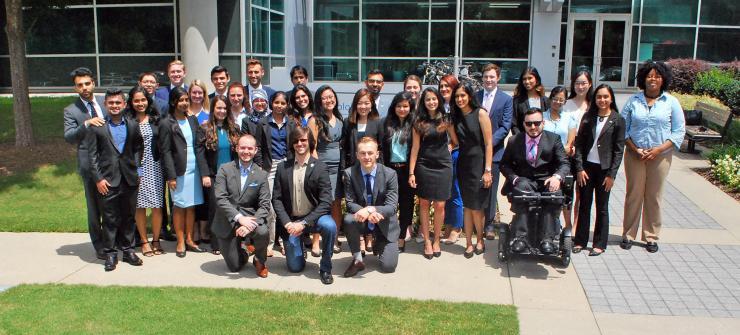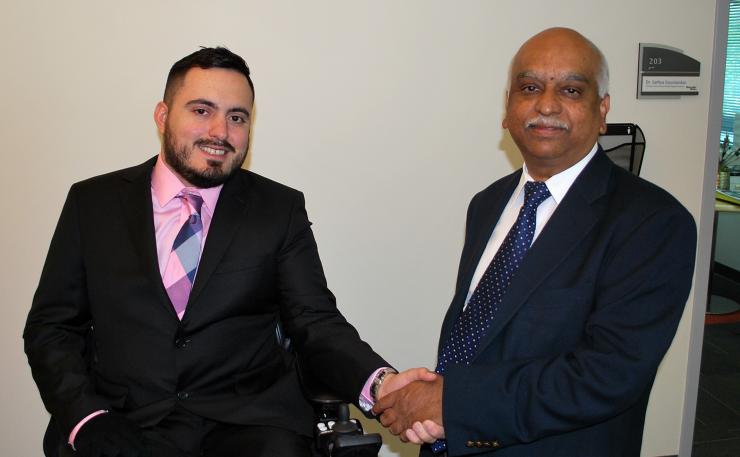MBID Unleashes New Group of Grads
Jul 31, 2018 — Atlanta, GA

The latest group of MBID graduates started the intensive one-year program the summer of 2017, and completed the journey last week.
An intensive whirlwind year of study and productivity ended last week for 34 new graduates of the Master in Biomedical Innovation and Development program, who wrapped up their final projects and live presentations for assembled clinicians, faculty, industry leaders, fellow and former students.
Moments later, the freshly minted grads, relieved of their academic burdens, took in some words of wisdom from guest speaker Howard Baker, vice president of quality and regulatory affairs for Facet Technologies, LLC.
“You may not realize it, but the easy part of your life is over,” said Baker, who has hired numerous graduates of the MBID program since it was launched in 2013. “This program was the easy part. Now the most fun part of your life, the most rewarding part of your life is about to start.”
The year-long MBID program was created by the Wallace H. Coulter Department of Biomedical Engineering at Georgia Tech and Emory to fill a market need for multi-talented, innovative professionals with detailed cross-training in biomedical device engineering, healthcare, and business development.
But according to program director Sathya Gourisankar, the idea isn’t to just create new workers for an evolving industry.
“Our diverse, project-based curriculum is producing graduates capable of working across a variety of roles,” said Gourisankar, who designed the program and has more than 30 years of pre-clinical and clinical biomaterials research and product development experience. “The long-term impact of the program will be the development of future industry leaders.”
The curriculum and training, which emphasizes real-world exposure and start-up industry experience, has developed 123 graduates in five years, many of them moving on to positions with industry leaders like Abbott, Baxter, Medtronic, Boston Scientific, Bard, Facett, and many others.
As with every year, this class was broken up into project teams (five of them, ranging in size). Before graduating, the teams are called upon to present and explain their bench-to-bedside medical device development efforts. Gourisankar presided over the three-hour event. Here are the five teams and their project summaries (if provided):
Team: ArthroOrtho; Members: Temiloluwa Adeniyi, Agnes Arrinda, Anshuj Deva, Jackie Kim, Ignacio Montoya, Prity Singh; Clinical Mentor: Dheera Ananthakrishnan, M.D. Description: The team designed a device to improve shoulder range of motion in adults with adhesive capsulitis that provides passive, cost-efficient, at-home, controlled (position, speed, and duration) therapy. Competitors lack the proper controls, which clinicians consider to be a desirable feature in shoulder therapy devices. This device, Armate, features a belt-driven pulley system controlled by two motors. Currently, the team plans to sell directly to both hospitals and patients as a rentable and reusable device.
Team: StoneDivus; Members: Tushar Agarwal, Shadi Ashtarolnakhai, Mattie Farris, Adam Majka, Kanchi Patel, Stuti Sagar, Hartie Spence III; Clinical Mentors: Spencer Kozinn, M.D., Jaime Wong, M.D., Raymond Pak, M.D. Description: Tackling the issue of recurring kidney stones, the team developed a device called Stasis, an at-home, point of care, active monitoring device that measures a patient's urine concentration and pH. The device is handheld, much like an electronic toothbrush, and detects urine analytes similarly to a pregnancy test. It incorporates wireless technology to record, store, and transmit actionable data to a patient’s smartphone, allowing for more direct control of care. Stasis aims to help patients discover their path to prevention.
Team: DextERmed; Members: Haris Shekhani M.D., Liuyi Meng, Ananya Gupta, Nadia Alam, Amrita Bhowmick, Prathamesh Prabhudesai, M.D., Florin Tirdea; Clinical Mentors: Lekshmi Kumar. M.D. Description: The team addressed the problem of improper ventilation, a common occurrence in and out of the hospital for patients using the bag valve mask. So they developed ZephER, a universal add-on device that fits between the bag and mask, ensuring that every time a bag is squeezed, the pressure delivered is less than lower esophageal sphincter opening pressure. Thus, there will be minimal air entry into the stomach and little to no subsequent complications.
Team: Enhanced; Members: Michael Chen, Christianna Imken, Jyuthika Sen, Sanjana Singh, Amulya Ananda Kumar, Jiaqi Qian, Jeremiah Mobley; Clinical Mentors: Robert Kelly, D.O. Description: Noting the dramatic increase of post-operative surgical site infections in obese patients requiring Cesarean sections, the team designed VenTrac Panniculus Manager, a single-use medical device intended to be used intra-operatively and post-operatively to help prevent infections.
Team: CirculaTech; Members: Rachel Aigen, Nicholas Bello, Kathleen Gonzalez, Stephen McClain, Jake Pistiner, Carson Schaff, Amirah Suleiman; Clinical Mentor: Gautam Kumar, M.D.
When the presentations were completed, the students fielded a barrage of tough questions from the audience, including industry veterans. It was the kind of potential pressure cooker that these grads will have to face in their careers, and they seem to have appreciated the experience, and the deep involvement of the business community in the program.
“The most effective element of the MBID program is the fact that we had industry professionals teaching us,” noted Jyuthika Sen. “It not only gave us insight into the industry practices, but also helped us understand the academic material in a more practical setting.”
As in past years, following each presentation and round of questioning, Gourisankar announced the team had fulfilled its graduation requirement. But this year represented a milestone for the MBID program – a designated 100th graduate. That honor went to Ignacio Montoya, who was on track to become a U.S. Air Force pilot when a road accident in December 2012 resulted in multiple injuries, including severe spinal cord damage that left him in a wheelchair. He plans to open a gait training center in the Atlanta area and serve as its executive director.
“None of that would be possible if it wasn’t for the staff of this program, Sathya and all of the faculty, everyone that has supported me,” Montoya said after final project presentations on Thursday, July 26. He also recognized departing executive director of the Petit Institute for Bioengineering and Bioscience at Georgia Tech, Bob Guldberg, for taking up his cause and bringing him to the attention of MBID leadership.
During the rigorous program, health issues occasionally posed a hurdle for Montoya. His dedicated ArthoOrtho teammates stepped up so the team could successfully complete their project.
“Every one of you has been there for me,” he told his audience last Thursday. “I’m here today, finishing this program, because of you.”

Sathya Gourisankar (right), director of the MBID program, congratulates its 100th graduate, Ignacio Montoya.

An audience of experts, including Petit Institute Executive Director Bob Guldberg (center), offered feedback and support to MBID students during final presentations.

MBID director Sathya Gourisankar offers some last minute advice to students shortly before their final presentations.
Jerry Grillo
Communications Officer II
Parker H. Petit Institute for
Bioengineering and Bioscience




